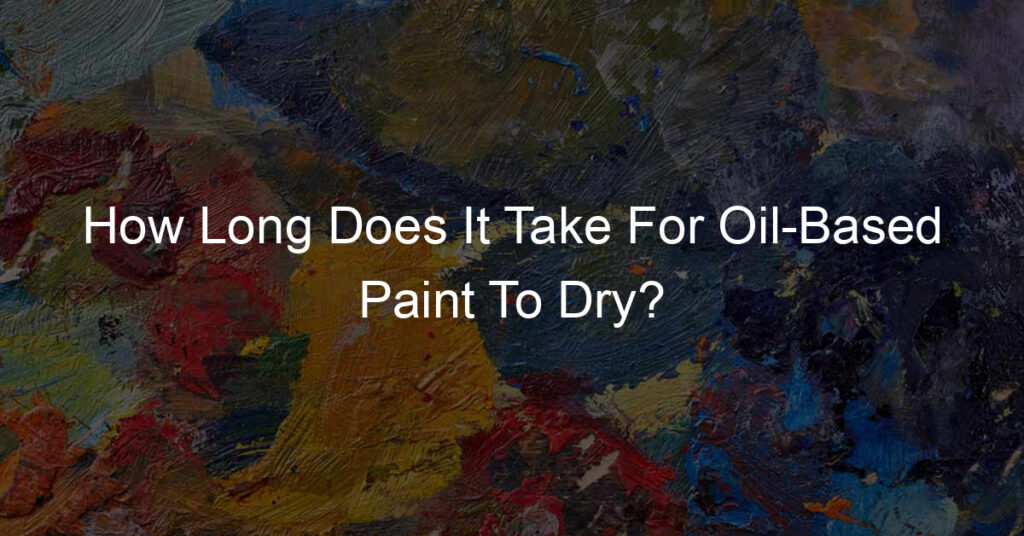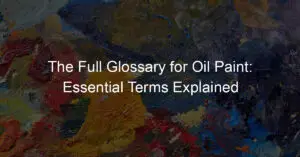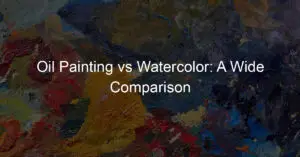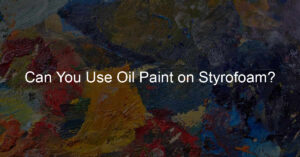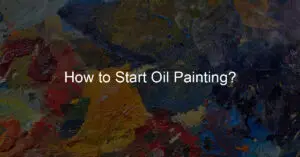Making oil paint is a process that takes time and patience. The first step is to mix the pigment with the linseed oil, using a mortar and pestle. You’ll need to grind the pigment really well until it becomes a fine powder. Then slowly add the oil, mixing continually until you have a thick paste.
Leave the mixture to stand overnight so that the oil can absorb into the pigment. The next day, you can start to thin it down by adding more oil until you get the consistency you want. If you’re not going to use it all at once, store it in an airtight container and put it in a cool place away from direct sunlight.
The Science Behind Oil-Based Paint Drying
Oil-based paint drying involves a chemical process known as oxidation. Unlike water-based paints that dry through evaporation, oil-based paints dry when the oil they contain reacts with oxygen in the air. This oxidation process transforms the oil into a hard, solid film.
The process is slow, typically taking at least 24 hours for a thin layer of paint. The paint also continues to harden over time, which means an oil-painted surface can remain workable for longer periods, allowing for changes and refinements.
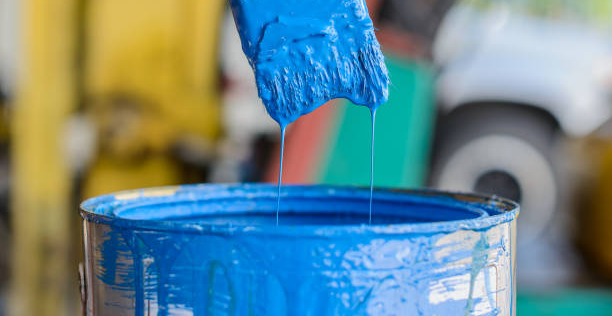
Factors Influencing the Drying Time of Oil-Based Paint
The drying time of oil-based paint can be influenced by several factors. First, the thickness of the paint layer matters; thicker layers will require more time to dry. Secondly, environmental conditions like temperature and humidity can affect drying times.
Warmer, drier conditions tend to speed up the drying process, while cooler, more humid conditions can prolong it. Lastly, the type and color of the pigment can affect drying times as well. Certain pigments dry faster than others; for example, lead white dries much faster than titanium white.
Common Mistakes While Using Oil-Based Paints
Several common mistakes can occur when using oil-based paints. One is failing to properly prepare the surface, which can lead to poor adhesion and uneven drying. Another common mistake is applying a second coat of paint before the first has fully dried, which can cause peeling and other issues.
Also, because oil-based paints take longer to dry, they can collect more dust and other airborne particles, so it’s important to protect them while they’re drying. Lastly, improper cleanup and disposal of oil-based paints can be harmful to the environment.
Handling Oil-Based Paint: Tips and Tricks
Handling oil-based paint can be a bit trickier compared to its water-based counterpart due to its longer drying time and different chemical composition. Here are a few tips and tricks: when applying the paint, use thin, even coats to promote even drying.
When not in use, ensure the paint can is properly sealed to prevent the paint from oxidizing and drying out. Use mineral spirits or turpentine for cleanup instead of water. And remember to dispose of any leftover paint or solvent in accordance with local regulations.
Safety Precautions When Using Oil-Based Paints
Oil-based paints contain solvents that can be hazardous to your health and the environment. Therefore, when using these paints, always work in a well-ventilated area to avoid inhaling toxic fumes. Wear protective clothing, including gloves and safety goggles, to prevent skin and eye irritation.
Avoid eating, drinking, or smoking while painting, and always wash your hands thoroughly after finishing your work. Additionally, store oil-based paints and solvents out of reach of children and pets, and dispose of them properly following local waste disposal guidelines.
Advantages and Disadvantages of Using Oil-Based Paints
Oil-based paints offer several advantages. They provide a smooth, high-gloss finish that is resistant to chipping and wear, making them ideal for high-traffic areas and surfaces. They also offer excellent adhesion, even on difficult surfaces.
However, oil-based paints also have their disadvantages. They have a strong odor, require longer drying times, and cleanup requires the use of solvents. In addition, they can yellow over time, particularly in areas with little exposure to sunlight.
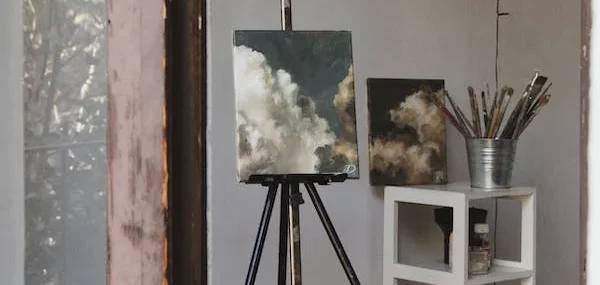
How To Properly Store Leftover Oil-Based Paint
Leftover oil-based paint should be stored in a cool, dry place, out of direct sunlight. The paint can should be sealed tightly to prevent air from entering and starting the oxidation process. If the can isn’t full, it’s helpful to transfer the paint to a smaller container to reduce the amount of air contact.
The Differences Between Oil-Based and Water-Based Paints
Oil-based and water-based paints differ in their composition, performance, and application. Oil-based paints, as the name implies, are made with oil (usually linseed oil) as the binder, which gives them a high level of gloss, durability, and resistance to wear and tear. They’re ideal for high-traffic areas, like kitchen cabinets, trim, and doors.
However, they have longer drying times, a strong smell, and require mineral spirits or turpentine for cleanup. On the other hand, water-based paints, also known as latex or acrylic paints, use water as the primary solvent. They have a quicker drying time, lower VOC content, and can be cleaned up with soap and water. However, they may not be as durable or provide the same level of gloss as oil-based paints.
In-Depth: The Composition of Oil-Based Paints
Oil-based paints are composed of three main components: pigment, binder, and solvent. The pigment provides the color, which can be derived from a variety of sources, including minerals, metals, and synthetic compounds.
The binder, which is usually linseed oil, binds the pigment particles together and to the painted surface. It also provides durability and gloss to the paint. Lastly, the solvent, often a petroleum distillate, keeps the paint in a liquid state until it’s applied. As the paint dries, the solvent evaporates, and the binder oxidizes to form a solid film.
Oil-Based Paint in Art: Historical and Contemporary Use
Oil paint has been a preferred medium for artists since its development in the Middle Ages, valued for its richness, depth of color, and flexibility. Artists such as Rembrandt, Van Gogh, and Monet have used oil paints in their famous works.
In contemporary art, oil paint remains popular because of its versatility. It can be applied in thin glazes or thick impasto and can be manipulated even after it has been applied to the canvas, allowing for changes and additions.
Its slow drying time, while potentially seen as a disadvantage in other applications, gives artists the freedom to work at a deliberate pace, refining and adjusting their work over time.
Does oil paint ever dry?
Yes, oil paint will eventually dry. However, it can take days or even weeks for it to fully cure. Once the paint is dry to the touch, you can protect it by applying a clear topcoat. This will help to keep the paint from yellowing or cracking over time.

how long does it take for oil-based paint to dry
It depends on the thickness of the paint, the temperature, and humidity of the environment, and how many coats you’ve applied. Generally speaking, oil-based paint will take about 24 hours to fully dry. However, it’s always best to consult the manufacturer’s instructions for specific dry times.
How do you get oil-based paint to dry faster?
There are a few things you can do to help oil-based paint dry faster (and protect it from dust while drying):
• Use a thinner coat of paint – This will help the paint to dry more quickly because there is less of it to dry.
• Apply a topcoat – Applying a clear topcoat over your oil-based paint can help it to dry faster.
• Use a hair dryer or fan – If you need the paint to dry quickly, using a hair dryer or fan to circulate air around the area can speed up the drying process.
• Increase the temperature – Turning up the heat in the room where you’re painting can also help the paint to dry more quickly.
Why is my oil-based paint not drying?
There are a few reasons why oil-based paint might not be drying:
• The paint is too thick – If the paint is too thick, it will take longer to dry. Try thinning it down with some additional oil.
• The environment is too humid – High humidity can prevent paint from drying properly. If possible, try painting in a drier environment.
• The temperature is too low – Paint can take longer to dry in cooler temperatures. If possible, try increasing the temperature in the room where you’re painting.
How do you know if oil-based paint is dry?
One way to tell if oil-based paint is dry is to touch it. If the paint feels dry to the touch, it is likely that it is fully dry. Another way to tell if oil-based paint is dry is to look at the sheen. If the paint has a dull appearance, it is probably dry. Finally, you can try using a hair dryer or fan to circulate air around the area. If the paint starts to show signs of drying, it is likely that it is fully dry.
Does oil paint dry faster in the sun?
No, oil paint does not dry faster in the sun. In fact, it can actually take longer for oil paint to dry in direct sunlight. The heat from the sun can actually cause the paint to blister and peel. If you’re trying to speed up the drying process, it’s best to use a hair dryer or fan to circulate air around the area.
What happens if you recoat oil paint too soon?
If you recoat oil paint too soon, the new coat of paint will not adhere properly and can cause the old paint to peel. It’s important to wait until the first coat of paint is completely dry before applying a second coat. Otherwise, you run the risk of damaging the paint job.
Oil-based paint is a type of paint that is made up of pigment, oil, and a binder. It usually takes about 24 hours for the paint to fully dry. However, it’s always best to consult the manufacturer’s instructions for specific dry times.

